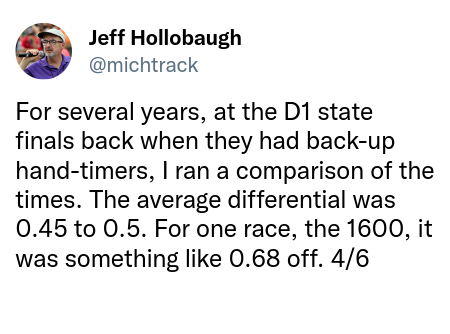There is a difference between FAT (fully automatic timing) and handheld times. If you talk to other coaches, you may hear them say FAT will look "slower" compared to handheld times.
Imagine the factors involved in hand timing. The gun goes off. The timer sees the smoke and then starts the watch. The timer then stops the watch when they think the runner crosses the finish line. Often this is early with timers anticipating the finish. So with hand timing, you are starting the watch a fraction late and stopping the watch a fraction early. Put those two pieces together and you have a time which will appear faster than FAT. Using a timer such as a sprint-8 (a timer with 8 plungers attached to it) is still hand timing. For those of you using an app, this still involves a human and is considered hand timing. A human is involved in starting and stopping the time.
With FAT the "human" is taken out of the equation. A sensor with the starting official picks up the gun or electronic start. This triggers the computer to start the clock. As the runners cross the finish line, a camera picks up the image for each athlete. The software then calculates the exact time for each athlete when their torso crosses the finish.
So why does it matter?
Coaches may want to take this information into account for your school records. This difference in time will affect the sprints more so than distance races. Maybe your boys 55 hurdle record is 8.5. What if someone at the county meet gets 8.53? Remember we said FAT will look slower compared to handheld times. Also, how was that 8.5 recorded in the first place? Was the proper procedure followed? When you hand time, your watch might say 8.51. Even though your watch says 8.51, you should be recording 8.6 on your official meet sheet. Sometimes the time instead is truncated (recorded as 8.5 even though it was 8.51). See your NFHS (National Federation of State High School Associations) rule book for Rule 3-8 Art. 3. You always round up to the next tenth of a second and record times in tenths when hand timing. If using FAT, you record times to hundredths. FAT actually will time to thousandths but it is recorded to hundredths.
How do you convert?
One option you have is to convert either the handheld times to FAT, or convert FAT to handheld. Which procedure you use depends on who you follow. The procedure to do this comes from Track & Field News' BIg Green Book which is now the Big Gold Book which is used by NCAA and USATF. NFHS procedure is similar except NFHS uses the same conversion factor for both sprints and longer races. Again, NFHS is our governing body for high school sports which Michigan follows.
To convert from hand to FAT for sprints up to 200 meters (55 hurdles, 70, 100, 200 & 200 hurdles):
This procedure is used by both the Big Gold book and NFHS. First round the time up to the nearest tenth. Then add 0.24. For example, if an athlete runs 8.51 in the 55 hurdles, it should be rounded up to 8.6. If on your meet sheet you already correctly rounded up to 8.6 you do not need to do it again. Now add the conversion of 0.24 which gives a final time of 8.84.
To convert from hand to FAT for longer races of 300 and up (400, 4x100 relay, 800, etc.):
Here is where the Big Gold Book and NFHS differ. The Big Gold Book uses conversion factor of 0.14, NFHS uses the same sprint conversion of 0.24. Since we follow NFHS I will explain using their procedure. First round the time up to the nearest tenth. Then add 0.24. For example, if an athlete runs 58.23 in the 400, it should be rounded up to 58.3. If on your meet sheet you already correctly rounded up to 58.3 you do not need to do it again. Now add the conversion of 0.24 which gives a final time of 58.54.
To convert from FAT to hand for all races you may use the Michigan rule:You will subtract 0.4 and then round up to the nearest tenth. For example, if an athlete runs 2:18.26 in the 800, you first subtract 0.4 which gives 2:17.86. Next round up to the next tenth which gives a final time of 2:17.9.
Caution, mixing "converted" hand times with FAT times is still problematic. Michigan track guru Jeff Hollobaugh says it best.

|

|
What does the Oakland County Meet do?
FAT was first used at the meet in 2008. When you look at the Individual Champions list, you will see all times before 2008 are recorded to the tenths and times starting in 2008 are recorded in hundredths. We have NOT converted any of the pre 2008 times to FAT equivalent. The times you see before 2008 are the actual hand times. All current County Meet records come from FAT meets only (2008 and newer) even if a hand time "looks" faster.
What does Athletic.net do?
Athletic.net follows the same procedure as USATF. When you enter results into athletic.net, if the time is hand time, athletic.net will convert it when displaying the time on their performance lists. You have the option of having the time display as is or to also convert it on your team page.
So what should I do about my school records?
This is not an easy decision. You will want to talk to your high school coaches to see what they are doing. Talk to coaches from other schools on how they handled it. Every situation is unique. Some schools have meticulous records for every year of their existence and some of you are in the situation where the previous coach did not keep track of anything or the meet sheets are lost. Possible options:
- convert any FAT to hand time
- convert all hand times to FAT
- keep records as is even if it is hand or FAT
- keep two records, a hand time list and FAT list
There are pros and cons to each of the options above. Whatever you choose, put it in writing so future coaches will know where those times on the record board came from.
